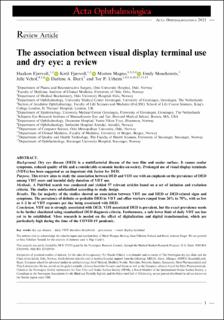| dc.contributor.author | Fjærvoll, Haakon Kristoffer Olsen | |
| dc.contributor.author | Fjærvoll, Ketil Andreas Olsen | |
| dc.contributor.author | Magnø, Morten Scherven | |
| dc.contributor.author | Moschowits, Emily | |
| dc.contributor.author | Vehof, Jelle | |
| dc.contributor.author | Dartt, Darlene A. | |
| dc.contributor.author | Utheim, Tor Paaske | |
| dc.date.accessioned | 2021-12-02T11:50:49Z | |
| dc.date.available | 2021-12-02T11:50:49Z | |
| dc.date.created | 2021-11-17T19:19:38Z | |
| dc.date.issued | 2021-10 | |
| dc.identifier.citation | Fjærvoll, H., Fjærvoll, K., Magno, M. et al. (2021) The association between visual display terminal use and dry eye: a review. Acta Ophthalmologica, 1-19. | en_US |
| dc.identifier.issn | 1755-375X | |
| dc.identifier.uri | https://hdl.handle.net/11250/2832559 | |
| dc.description.abstract | Background
Dry eye disease (DED) is a multifactorial disease of the tear film and ocular surface. It causes ocular symptoms, reduced quality of life and a considerable economic burden on society. Prolonged use of visual display terminals (VDTs) has been suggested as an important risk factor for DED.
Purpose
This review aims to study the association between DED and VDT use with an emphasis on the prevalence of DED among VDT users and harmful daily duration of VDT use.
Methods
A PubMed search was conducted and yielded 57 relevant articles based on a set of inclusion and exclusion criteria. The studies were subclassified according to study design.
Results
The far majority of the studies showed an association between VDT use and DED or DED-related signs and symptoms. The prevalence of definite or probable DED in VDT and office workers ranged from 26% to 70%, with as few as 1–2 hr of VDT exposure per day being associated with DED.
Conclusion
VDT use is strongly associated with DED. VDT-associated DED is prevalent, but the exact prevalence needs to be further elucidated using standardized DED diagnosis criteria. Furthermore, a safe lower limit of daily VDT use has yet to be established. More research is needed on the effect of digitalization and digital transformation, which are particularly high during the time of the COVID-19 pandemic. | en_US |
| dc.language.iso | eng | en_US |
| dc.publisher | John Wiley & Sons Ltd on behalf of Acta Ophthalmologica Scandinavica Foundation | en_US |
| dc.rights | Navngivelse-Ikkekommersiell 4.0 Internasjonal | * |
| dc.rights.uri | http://creativecommons.org/licenses/by-nc/4.0/deed.no | * |
| dc.subject | tørre øyne | en_US |
| dc.subject | skjermbruk | en_US |
| dc.title | The association between visual display terminal use and dry eye: a review | en_US |
| dc.type | Peer reviewed | en_US |
| dc.type | Journal article | en_US |
| dc.description.version | publishedVersion | en_US |
| dc.rights.holder | © 2021 The Authors | en_US |
| dc.subject.nsi | VDP::Medisinske Fag: 700::Klinisk medisinske fag: 750::Oftalmologi: 754 | en_US |
| dc.source.pagenumber | 1-19 | en_US |
| dc.source.journal | Acta Ophthalmologica | en_US |
| dc.identifier.doi | 10.1111/aos.15049 | |
| dc.identifier.cristin | 1955701 | |
| cristin.ispublished | true | |
| cristin.fulltext | original | |
| cristin.qualitycode | 2 | |

